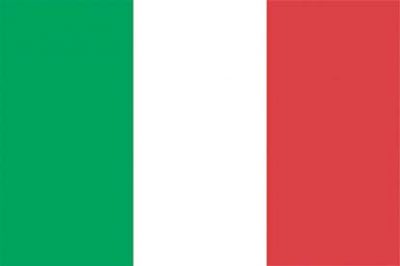
 The Port of Naples is dominated by the brooding bulk of Mount Vesuvius, a sleeping volcano that last exploded in 1944 with large loss of life and the destruction of the funicular railway to the top, and is unpredictable as to when it will explode again. It is a source of fear and wonder to the residents of Naples, and from a lofty 3,750 feet the view from the top is magnificent, taking in a sweeping panorama of Naples, Sorrento and the islands of Procida, Ischia and Capri. If you wish to see the effects of the power of pyroclastic blasts and molten lava on the local population, visit the ruins of Pompeii or Herculaneum, once great cities whose entire population was snuffed out in a few minutes. The Port of Naples suffered considerable damage from earthquakes in 1980 with three thousand people killed in the Campania region around Naples. Since then, the area to the west of Naples has suffered from major rises and falls of the land, and there were serious mudslides in 1998. The Port of Naples is an arc shaped port and has a splendid view southwards over the beautiful Bay of Naples and the islands of Capri, Ischia and Procida.
The Port of Naples is dominated by the brooding bulk of Mount Vesuvius, a sleeping volcano that last exploded in 1944 with large loss of life and the destruction of the funicular railway to the top, and is unpredictable as to when it will explode again. It is a source of fear and wonder to the residents of Naples, and from a lofty 3,750 feet the view from the top is magnificent, taking in a sweeping panorama of Naples, Sorrento and the islands of Procida, Ischia and Capri. If you wish to see the effects of the power of pyroclastic blasts and molten lava on the local population, visit the ruins of Pompeii or Herculaneum, once great cities whose entire population was snuffed out in a few minutes. The Port of Naples suffered considerable damage from earthquakes in 1980 with three thousand people killed in the Campania region around Naples. Since then, the area to the west of Naples has suffered from major rises and falls of the land, and there were serious mudslides in 1998. The Port of Naples is an arc shaped port and has a splendid view southwards over the beautiful Bay of Naples and the islands of Capri, Ischia and Procida.
History Of The Port Of Naples
Greeks, Romans, Byzantines, Normans, Spanish and French rulers have all controlled Naples over the last two thousand years. The French Bourbon family ruled Naples until 1860, and the Italian peninsula system of separate States e.g. Campania for the Naples area, Tuscany, Piedmont etc. held sway until the unification of these many disparate States into one Italian country took place in 1861. The first steamship in the Mediterranean set out from the port in 1818, and a shipyard was established in the port shortly afterwards. However, emigration to New York and the United States of America with over four million people leaving the area up to the 1910s decade, tells the decline of the area after unification.
World War II saw Naples as a major supply port for the German and Italian campaigns in North Africa. Naples became the most bombed port in Italy by the Allies, and after the Italian surrender on 8th September 1943, the British Eighth Army suffered major casualties from the retreating Germans and from malaria, which was prevalent in the area at that time. After a four day uprising by the people of Naples following the surrender, the occupying German forces were driven out of the city. Emigration in the immediate aftermath in the late 1940s was again huge as Neapolitans could not see a good living and a future in their city. Government spending to improve the infrastructure in the 1950s halted the emigration to some extent. Shipowner Achille Lauro became Mayor of Naples in 1952, with the new housing stock of terraced houses now replacing the destruction of war. However, the city still suffers today from very high unemployment and fears regarding the stability of the volcanic and earthquake prone nature of the land.
The express Transatlantic liners of Italia Line, Rex and Conte di Savoia in the 1930s, and Augustus of 1951, Giulio Cesare of 1952, Cristoforo Columbo of 1954, the ill fated Andrea Doria of 1953, Leonardo da Vinci of 1960, and the twin funnelled Raffaello and Michelangelo of 1965, saw the heyday of Naples as a Transatlantic port of emigration from the iconic Stazione Marittima, and now part of the Cruise Terminal. The Port of Naples remains today as a passenger hub for millions of passengers that pass through each year on their way to or from cruise destinations across the world, or on short trips around the beautiful Bay of Naples to Sorrento and the Amalfi Coast or the islands of Capri and Ischia in the Bay. Naples, of course, is a tourist destination in its own right, with cruise passengers arriving in the port at the excellent and ideal location of the Cruise Terminal from which to explore the famous buildings and beauty spots of the city. The total of both cruise passengers and Bay tourists is now well in excess of ten million passengers per annum.
CARGO TRAFFIC STATISTICS for 2014
- Dry Bulk – 342 Mtonnes
- Liquid Bulk – 672 Mtonnes
- Container Goods – 615 Mtonnes
- Ro-Ro – 496 Mtonnes
- TOTAL – 125 Mtonnes
The totals for oil and liquid bulk would have been a lot higher if it were not for a disastrous fire on 21st December 1985 at the Q8 terminal. An explosion and fire destroyed two dozen of the 32 large storage tanks after a blaze had broken out when one of the tanks was overfilled. The disaster completely destroyed all of the terminal pipelines, offices and other terminal buildings with a financial loss of sixty million U.S. dollars. Nearby industrial and residential property was also destroyed, and the local Rimorchiatori Towage Company lost a significant part of its business from the berthing and unberthing of large tankers that then no longer called at Naples.
Port Of Naples Facilities Passengers
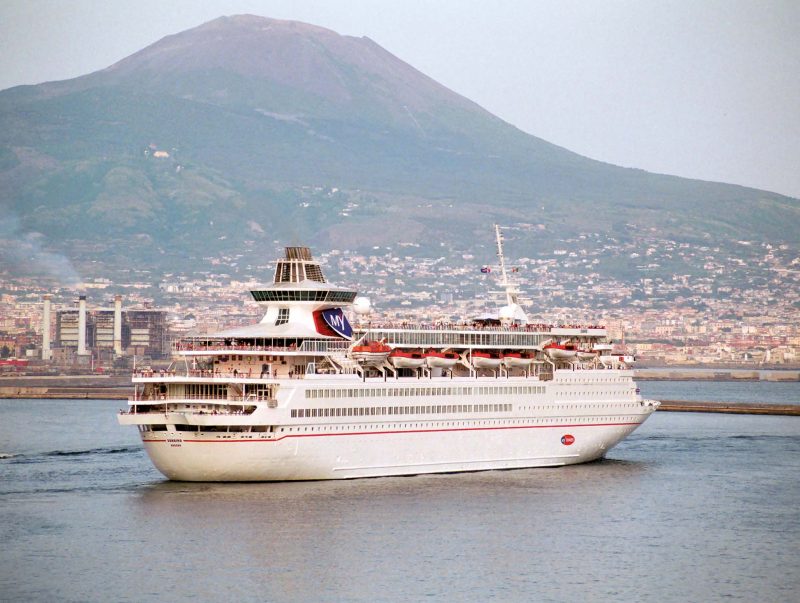
There are four berths for large cruise ships of around 100,000 grt, primarily used by Costa Cruises, Holland America Line, Celebrity Cruises and MSC Cruises, at the Naples Cruise Terminal. The combined total of cruise ships calling at Naples of Costa Cruises and MSC Cruises is well over one hundred during the 2017/18 cruising season. There is also a front berth to the huge terminal for smaller ro-paxes that bring in both passengers and cars. Two ro-paxes of TTT Lines (Tomasos Transportes Touristicos) named Trinacia and Partenope, with passenger accommodation for 950 passengers, use this front berth on their route to Catania in Sicily. TTT Lines was 50% purchased by Grimaldi Lines on 28th October 2016. The Naples Cruise Terminal is a joint stock company with a 5% holding owned by the Port of Naples, and it manages the terminal, assists cruise vessels, and serves passengers from its office in the Stazione Marittima, opposite Castel Nuovo. The berths are a total of 1,100 metres long with an alongside depth of 11.0 metres, and there are seven mobile gangways if seven smaller cruise ships are berthed on any one day. A dozen cruise passenger check-in desks speed the flow of around two million cruise passengers per annum. Cruise ships also berth at the Beverello and Calata Porta di Massa quays if the main cruise terminal is fully occupied.
The ferry passengers travelling to Cagliari (Sardinia), Stromboli and the Aeolian Islands, Porto Vecchio (Corsica) or Palermo (Sicily) on SNAV, Moby Lines, Tirrenia CIN, or the high speed AIilauro craft, leave from the Beverello and Molo Immaculata Vecchio quays on the next part of the arc shaped port from the Cruise Terminal. The next quay of Calata Porta di Massa Quay also handles ferry and Bay of Naples tourists of Medmar, Caremar and Navigazione Libera del Golfo (NLG). NLG was formed in 1953 for tourist trips around the beautiful Bay as well as Sorrento and the Amalfi Coast and the islands of Capri and Ischia. NLG started with the small Italia and Linda ferries, and have since used traditional vessels e.g. Ala, Patrizia, Mergellina, Santa Teresa, Santa Lucia Luntana, Santa Maria del Mare, Santa Rita, Pola, Santa Lucia and Santa Maria. The company currently uses six high speed jet craft from Naples in Amalfi Jet, Capri Jet (purchased in 1988), Ischia Jet, Napoli Jet, Sorrento Jet and Vesuvio Jet, with three other high speed craft to other Italian islands from other Italian ports.
Dry Bulk Handling
There are several berths further round the arc shaped port past the central Cantieri del Mediterraneo shipyard e.g. Calata Vittorio Veneto of length 250 metres, and also at the Flavio Gioia, and Vittorio Emanuele quays. The reception silos at Calata Villa del Popolo are of 40,000 tonne capacity for vessels on both sides of the quay, the pier is of length 110 metres, with four grain suction turbines as well as pulverising equipment. Much of the imported wheat and grain is destined for the alimentary industry of Campania, Umbria and Marche regions. Two further companies in the port handle the significant cellulose traffic, and there also large dry bulk movements of timber and chemicals. The storage facilities for cereals are 75,000 square metres, and 35,000 square metres for cellulose and timber.
Liquid Bulk Handling
The Naples Oil Terminals at Petroli Quay (length of 950 metres) and the Flavio Gioia Pier handle refined products such as diesel oil, fuel oil, petrol, agricultural and Avgas jet fuel, which make up half of the total. The other half is vegetable oils, liquid petroleum gas (LPG), and speciality oils that are moved to the Campania region. The Oil Terminals are located to the east of the General Cargo, Dry Bulk and Container Terminals, with a large Industrial Zone of the port to the east of the Oil Terminals.
Container Terminals
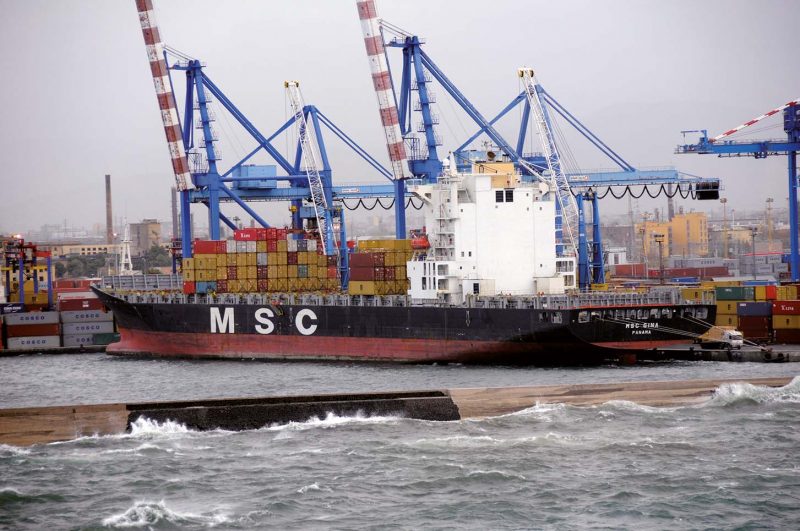
There are two container terminals in the Port of Naples at the Bausan Terminal and the Flavio Gioia Terminal. Further much smaller movements of containers may occur at the Pollena Quay and Vittorio Emanuele Quay. Container traffic has increased year over year for the last twenty years and stands at 600,000 TEU per annum. The Bausan Terminal is of 960 metres in length and has four gantry cranes of 50 tonne capacity and three mobile cranes of 110 tonnes capacity. The Flavio Gioia Terminal is of length 685 metres and uses three mobile cranes of 60 and 100 tonnes capacity. The container storage yards cover 1.336 million square metres.
Ro-Ro Traffic
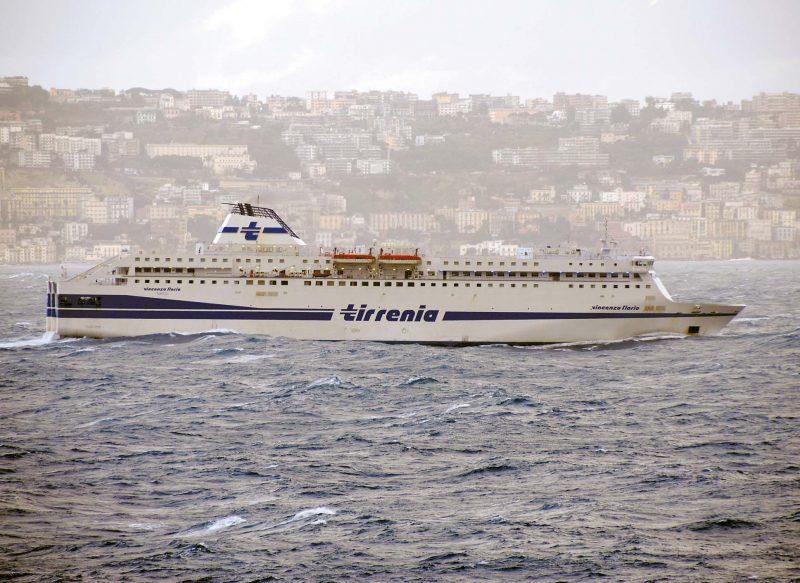
Automobile imports and exports have increased dramatically in recent years with new regular coastal shipments to Sicily increased by large numbers of heavy trucks avoiding the overcrowded Italian roads and using the ‘Autostradas of the Seas’ instead. The shipments are handled at Calata Porta di Massa quay of length 720 metres, Immacolata Vecchia quay of length 720 metres at right angles to Porta di Massa in the Bacino del Piliero, and Vittorio Emanuele quay of length 300 metres. The daily traffic to Sicily is one thousand trucks and cars, with over a million trucks and cars handled per annum to and from all destinations.
Naples Quays and Piers from West to East
There are five breakwaters protecting the port ranging from 280 metres in length to 1,570 metres in length, and two entrances to the port in the Bocca Principale (west) of 300 metres in width and the Bocca di Levante (east) of 245 metres in width. The surface area of the harbour is 2.56 million square metres, and vessels drawing up 45 feet of water can be accommodated. The quays and piers from west to east are:-
- Molo Beverello used by Alilauro high speed craft and Bay of Naples tourist boats.
- Molo Angioino (Cruise Terminal).
- Calata Piliero of length 290 metres, used by large ferries moored Mediterranean style stern first.
- Molo Immacolatello Vecchia (Ferry Terminal), three berths used by large ro-ro ferries moored stern first.
- Calata Porta Massa of length 320 metres with alongside depths of 8.0 metres, used by ferries e.g. Tirrenia CIN.
- Molo Carlo Pisacane with a total of five berths on the east and west sides, and a pierhead of length 100 metres and alongside depths up to 10.0 metres.
- Calata Villa del Popolo of length 345 metres for general cargo and cereals and alongside depth of 7.0 metres, and two silo berths of 100 metres in length.
- Molo Carmine of length 350 metres on the west side for general cargo, with alongside depth of up to 8.5 metres.
- Cantieri del Mediterraneo Shipyard (formerly Societa Navalmeccanica) with an alongside depth of 7.0 metres and three dry-docks.
- Molo Martello of 350 metres in length with four berths for vessels carrying hazardous cargoes, alongside depth of 8.5 metres.
- Calata Marinella of length 200 metres used for cereals.
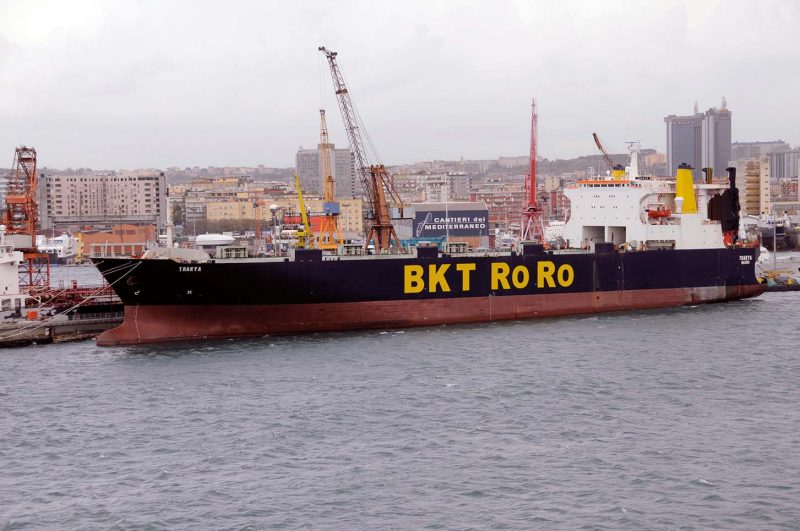
- Vittorio Emanuele with west side of length 355 metres, the pierhead is 170 metres, and the east side of length 310 metres, for general cargo and containers.
- Calata Vittorio Veneto of length 210 metres with alongside depth of 8.5 metres.
- Flavio Gioia Container Terminal with west side of 248 metres in length, pierhead of 102 metres, and east side of 250 metres in length.
- Calata Granili of length 200 metres with alongside depth of up to 10.3 metres.
- Bausan Container Terminal with west side of 248 metres in length, pierhead of 120 metres, and east side of 270 metres, and alongside depth of 15.0 metres.
- Calata Pollena of length 120 metres with one berth for tankers with alongside depth of 10.0 metres.
- Oil Terminal with storage tanks for all types of oils as well as liquid petroleum gas.
The wet docks and basins in the port are Darsena Ferdinando Acton, Bacino Angioino, Bacino del Piliero, Darsena del Bacini, Bacino Nuovo, Darsena Armando Diaz, Darsena Vittorio Veneto, Darsena dei Granili, Darsena Pollena, and the Darsena Petroli (Oil Terminal). There are over forty cranes in the port, ranging from container gantries to mobile cranes, grain turbo suction aspirators, as well as rubber tyred cranes, and many fork lifts.
Cantieri Del Mediterraneo Shipyard
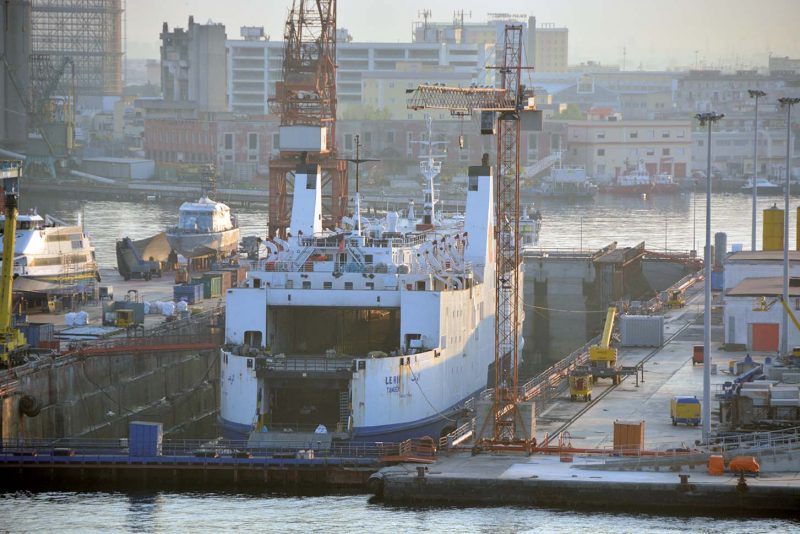

This important repair shipyard is located in the centre of the Port of Naples, and specialises in the repair and conversion of large and medium sized cargo ships, warships as well as trawlers, coasters, yachts and small craft. It was founded in 1911 as the Societa Esercizio Bacini Napoletani spA for repairing small ships on two slipways and two dry docks. The building and construction of small vessels began during 1918/23, but during the crisis of 1929 in shipbuilding, conversions of cargo ships into passenger liners were undertaken. During the next decade until the outbreak of World War II, the workforce grew from only one hundred to just under two thousand in four locations at Navalmeccanica Yard in the centre of the Port of Naples, the Vigilena yard in the east of the port, at Castellammare di Stabia near Sorrento, and at several mechanical workshops and foundries spread around the port.
The Castellammare di Stabia yard is situated thirteen miles south east of Naples in the Bay of Naples, and is a large yard in a harbour protected by the Foraneo Pier near the yard and the Sottoflutto Pier on the other side of the harbour. In post-war years, the yard launched large bulkers, ro-paxes, container ships and tankers for the owning Fincantieri Group, with Grimaldi Lines taking many of their ro-ro fleet from the yard. The yard now manufactures sections of large cruise ships e.g. Britannia of P. & O. Cruises in 2015, which are towed away to be assembled in other Fincantieri yards in Italy.
The output of these yards was entirely for the Italian Navy during World War II, but all of the facilities were completely destroyed by Allied bombing in 1943. The resumption of shiprepair work took a long time, with Dry Dock 1 of length 387 feet, breadth of 59 feet and depth of 24.3 feet, and Dry Dock 2 of length 689 feet, breadth of 95 feet and depth of 32.9 feet soon joined by a new larger drydock on a new yard extension into the harbour. Dry Dock 3 was big at 1,145 feet in length, breadth of 147.7 feet and depth of 42.8 feet, with Societa Navalmeccanica becoming part of the Fincantieri Group in 1955 when the new dock was opened.
In 1964, a major investment programme was begun by the Fincantieri Group for the Naples yards, with much renewal of outdated equipment and the provision of two new Floating Docks in Dock 4 with a 28,000 tonne lifting capacity, and Dock 5 with a 20,000 tonne lifting capacity. A total of five graving and floating docks ensured the yard a prosperous post-war period, which continued after 1981 when the Naples yard was merged with those at Taranto under the name of Fincantieri Cantieri Navali Italiana spA.
A group of private Neapolitan investors bought out the Naples yard in 1993 and renamed it as Cantieri del Mediterraneo. The yard is very modern with a big area of 150,000 square metres, and several dry docks for the repair of merchant and naval vessels. The facilities include a General Warehouse and a Mechanical Workshop, each of 4,500 square metres in area, a Prefabrication Shed of 5,500 square metres in area, with ship sections repaired by lathes, cutting machines, vertical drills, saws, grinding and boring machines, oxyacetylene and hot thermal cutters, and heavy cold bending machines. Steel plates can be cut up to 25 mm in thickness, and there are three cranes at the quayside with capacities of 50 tonnes lift. The repair yard is very visible in the centre of the Port of Naples, with ‘Cantieri del Mediterraneo’ written in huge letters at the top of the prefabrication sheds and other workshops. There are three other small shipyards in the Port of Naples in Nuovo Meccanica Navale, Palumbo spA, and Cantieri Megaride.
Rimorchiatori Harbour Tug Fleet
This family fleet has been operating in Naples harbour for almost 140 years since 1880, and was created by a group of eight Neapolitan families. A fleet of eight harbour tugs was operated in the 1930s in A. Whitting 116/94, Carlo Bruno 116/17, Impero 157/37, L. Starita 180/30, Littorio 208/27, Rimorchiatori 223/33, San Benigno 109/07, and Spagna 103/06 plus the salvage tug Vesuvio 243/31. The latter tug was built by Alexander Hall & Co. Ltd. at Aberdeen in March 1931 as Contest for the Elliott Steam Tug Co. Ltd. of London and purchased by Rimorchiatori in October 1932 and renamed. She had a sister named Challenge, which is still afloat today as a preserved tug at Southampton, and was replaced by another Contest in 1933. Vesuvio was seized by the German Navy in September 1943 and bombed and sunk at Livorno on 17th March 1944. She was raised and renamed Vesuvius in 1954 and served the company until broken up by Tirrena SNC at Naples in March 1981.
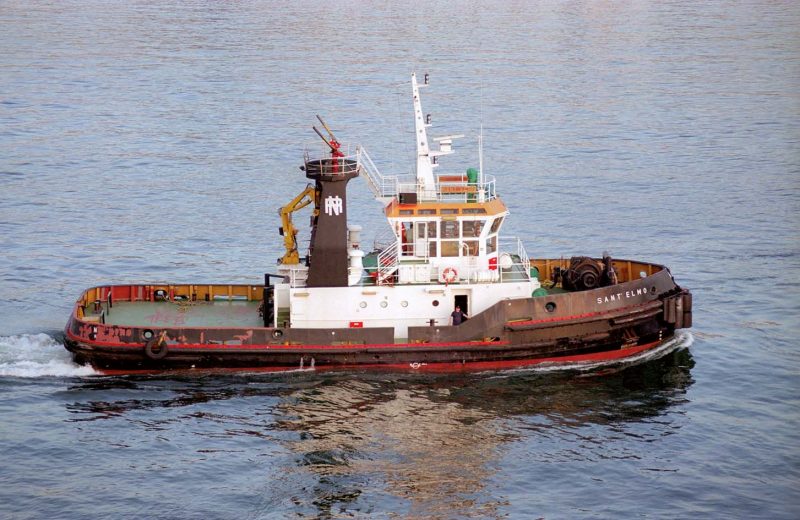
The company extended its towage activities at the end of World War II to the ports of Bari, Taranto and Gaeta. Steam tugs owned at this time included Andrea 189/25, Bonaria 222/29, Giuseppe Irrera 120/09, and Sparviero 331/39, with further new steam tugs built in post-war years e.g. Sergio 247/46, Possente 256/51, Capo Ferrato 206/56, Capo Figari 220/56, Caprera 206/56, Figari 227/57, Terralba 228/56. New diesel powered tugs were built from 1957 including Oristano 176/57, Moretto 197/60, Tenace 235/66, Vincente 237/70 and Vigore 237/73. A former British ‘Empire’ tug was also in the fleet in Poetto 316/45 purchased in 1969 as Serviceman from United Towing Ltd. of Hull and completed as Empire Stella at Selby as a steam tug and converted to diesel power in 1961. The former Empire Sheila 287/45 also from Selby was purchased in 1963 and renamed Tirso.
Rimorchiatori Riuniti has expanded in recent times into the North Sea offshore market through their Portosalvo Ltd. of London, and into deep sea barge towage through their Rimorchiatori Meridonali company. Andrea de Domenico became President of the company in 1998, and presides over a Board of thirteen partners, four having operational roles. The fleet had to be reduced after a serious loss of business after the Q8 fire and explosion at Naples on 21st December 1985, with a significant drop in business when deep sea tankers no longer called at the port. The fleet was later built up with the diesel powered tugs Danimarca 148/88, Galesus 404/92, Punta Campanella 404/92, Punta Scutolo 411/92, Sant Elmo 248/93 and Sveza 148/88. The company Head Office is now at Via Agostino Depretis and the Operations Office is at Vittorio Emanuele quay, with the tugs berthed at the Pisacane Quay. The company employs 85 workers at Naples with sixty working on the tugs, which nowadays only have a crew of two or three, a dozen administrative staff and the remainder as diesel engineers maintaining the fleet.
Rimorchiatori Napoletani now has a fleet of 22 tugs of up to 5,600 bhp powered by the latest types of propellers with a draft of five metres and costing 8.5 million euros each. However, the total Rimorchiatori Riuniti fleet is now eighty tugs, with the remainder of the fleet now working at Venice, Genoa, La Spezia and Palermo. Three offshore supply ships of Portosalvo Ltd. work within the Gulf Offshore Consortium as Enea 3,639/10, Gargano 2,244/02 and Portosalvo 2,154/05.
Ilva Iron And Steel Plant at Bagnoli Near Naples
Rimorchiatori tugs were also sent round to the Bagnoli harbour, five miles west of Naples to berth iron ore carriers at two berths, the North Pier of 647 metres in length with berths for two ships up to 14.0 metres in draft, and the South Pier of 384 metres in length with berths for two ships up to 10.0 metres in draft. Ten cranes of up to 12.5 tonnes capacity discharged the iron ore on to conveyor belts to reach the iron and steel plant. The Bagnoli iron and steel plant was inaugurated on 19th June 1910 after five years of construction on 120 hectares of low cost land next to the seashore for Ilva of Genoa, later the factory was renamed Italsider in 1964. The site was to the west of Cape Posillipo and had huge blast furnaces with 3,700 workers in 1955, with the employer providing subsidised meals in the works canteen. This industrial steel plant, like others in Northern Europe, has since closed down in the 1990s, and was dismantled with the scrap sold and exported to foreign buyers.
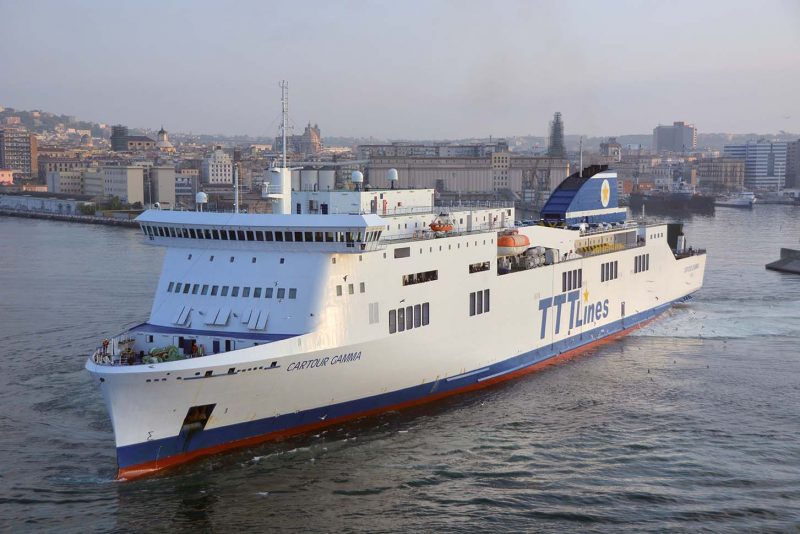
Port Ancillary Services
The Port of Naples Corporation of Pilots was instituted by Royal decree on 7th June 1866, with the number of pilots numbering in the dozens when ships entering the port were smaller. Today, there are over a dozen pilots carrying out navigation duties on around one thousand ships per month, and working from a 35 metre high white control tower situated in a prominent point in the port. The tower was completed during Millennium year and is perfectly placed for ‘sighting’ ships arriving in the Bay, although of course it has a VHF monitoring and control system with the latest equipment. All of the pilots are equipped with personal VHF so that they can listen continuously to the pilot station and be ready to react at a moment’s notice to the 24 hour service, 365 days a year. The Corporation of Pilots operate three fast launches of 42 feet in length with a cruising speed of eighteen knots in the Bay of Naples. Wind conditions determine ship movements, but fortunately Naples is sheltered and wind speeds of over forty knots are uncommon. All ships with a gross tonnage of 500 or more need compulsory pilotage, with the only exception being for regular ferries with Masters having much experience in entering and leaving the port and who speak the Italian language.
The Mooring and Ferrying Group in the port was created in 1946, with a fleet of six launches for mooring work and three launches with accommodation for sixty passengers for ferrying work. The Operations Room has VHF and modern technology to have constant contact to the total of three dozen workers of both groups. The mooring men, known as foyboatmen in British ports, have separate functions to the ferrying men, who ferry passengers from the harbour to the port. The large number of ferry movements of six big ferry companies operating from the port, dictate this type of mooring and ferrying organisation. The Beverello and Calata Porta di Massa quays are usually crowded, with the mooring men often asking for police assistance in keeping users away at a safe distance from the mooring operations.
New Developments
The Port of Naples Authority Operating Committee, together with the Terminal Operators Committee, and the Gennaro Moccia Trade Union representing port workers, oversee new developments for the port. The new extension of the Eastern Dockyard has been mooted for years and progress has been very slow in making it happen. This extension of the Eastern Dockyard will add a further 200 metres of quay to the existing 11.5 kilometres of quays. The overall length of the new Eastern Container Terminal will be 670 metres, allowing two container ships of 6,000 EU capacity or one of 11,000 TEU capacity to be berthed.
Trevi Construction has been working during 2016/17 in the clean-up of the site, removing polluted materials from the bottom of the harbour, and providing landfill and drainage systems for the new project that juts well out into the harbour. The existing container terminal is being modified with seven hectares of open water that is partially enclosed by two piers of length 250 metres and a width of seventy metres. Alongside depth of the new terminal will be 15.0 metres with dredging at a later date to 18.0 metres to allow larger container ships to berth. There will be three large container gantry cranes, 22 straddle carriers to move containers around the site, and the provision of a new rail link into the terminal as well as inter-modal facilities to move containers between rail and trucks from the nearby motorway network. The inter-modal facility will have container weighing of every container brought in to ensure no seriously overloaded containers ever get anywhere near the container ship.
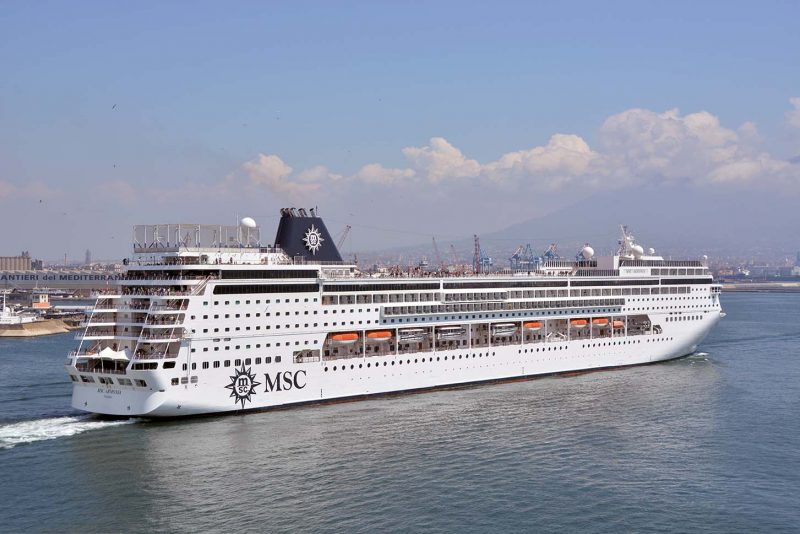
Postscript
I have always admired the work of the pierhead artists of the Naive school of marine painting at Naples, with good profiles of sailing ships and early steamers at sea, usually with a smoking or erupting Vesuvius in the distant background. Numerous examples of paintings of Italian, British, German, Norwegian and other nationalities ships exist today, but the pierhead artists remain unknown and not recognised for their consummate skill in oil painting. The period these lovely paintings covered was from 1860 to 1910, with accurate profile representations of the hulls, holds, rigging and accommodation of these early ships.
The Port of Naples is a vibrant and busy port based on tourism, commerce and industry, with a hectic ferry and cruise passenger trade, a moderate container terminal business, and a very busy shiprepair yard. Naples is also home to growing electronic, automobile and aircraft manufacturers, with the iconic Alfa Romeo sports cars factory based in the city. Neapolitan coffee is known throughout the world for its famous taste, and the rapidly growing food processing industry of the city is essential to the service and tourist based economy of the port.

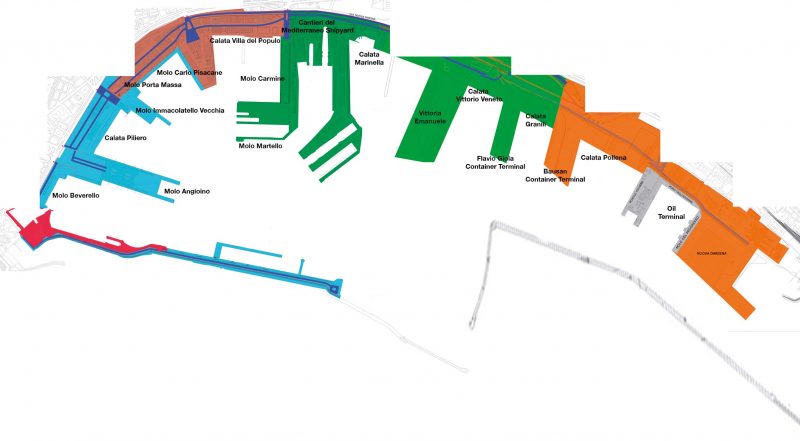
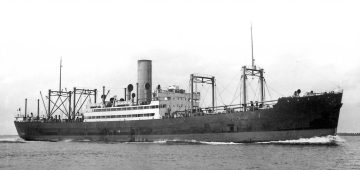



Comments
Sorry, comments are closed for this item